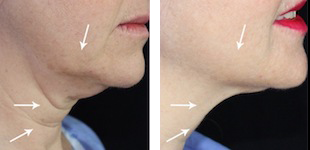Botox for Facial Slimming & Teeth Grinding
Conveniently located to serve the areas of Santa Monica and Los Angeles

Botox (short for Botulinum Toxin) is a neurotoxin that is often used for cosmetic and medical purposes. One of its cosmetic applications is for the treatment of masseter hypertrophy, a condition where the masseter muscles in the jaw become enlarged, resulting in a square or overly prominent jawline. Here’s what you should know about Botox for masseters:
Why is Botox used for the treatment of masseter muscles?

Procedure: Botox injections for masseters involve injecting the toxin directly into the masseter muscles on each side of the jaw. The injections are typically done in a series of small injections.
Mechanism of Action: Botox works by temporarily paralyzing the muscles it’s injected into. In the case of masseters, it reduces the muscle’s ability to contract, leading to a softening of the jawline and a reduction in the appearance of a square jaw.
Purpose: The primary purpose of using Botox for masseters is for cosmetic reasons. It can help achieve a more oval or heart-shaped face, which is often considered more feminine. Some people may also choose this treatment to alleviate symptoms of jaw clenching and teeth grinding (bruxism) because it can reduce muscle tension in the jaw.
Duration: The effects of Botox on masseters are temporary, typically lasting for about 3 to 6 months. After this period, the muscle gradually regains its strength and size, so repeat treatments are necessary to maintain the desired results.
Side Effects: Botox injections for masseters are generally considered safe when performed by a trained and experienced healthcare provider. Common side effects include temporary soreness at the injection site and the possibility of mild weakness in the jaw when chewing. More serious side effects are rare but can occur.
Consultation: Before undergoing Botox treatment for masseters, it’s important to have a consultation with a qualified healthcare professional who can assess your specific needs and provide recommendations based on your facial anatomy and desired outcome.
Cost: The cost of Botox for masseters varies depending on factors such as the provider’s location, their experience, and the amount of Botox required. It’s typically considered a cosmetic procedure and may not be covered by health insurance.
Alternatives: There are surgical procedures, such as jaw reduction surgery (also known as jaw contouring or V-line surgery), that can achieve permanent changes in jawline shape. However, surgery involves more risks and downtime compared to Botox injections.
Is Botox used for grinding teeth?
Botox (short for Botulinum toxin) is sometimes used to treat conditions related to muscle tension and spasms, including bruxism, which is the medical term for teeth grinding. Here’s some information on how Botox can be used for this purpose:
How it works: Botox is a neurotoxin that works by blocking nerve signals in the muscles where it is injected. In the context of teeth grinding, it can help relax the muscles responsible for clenching and grinding, which can provide relief from the symptoms associated with bruxism.
Treatment process: If a dentist or medical professional determines that Botox is an appropriate treatment for your teeth grinding, they will typically inject small amounts of the toxin into the muscles involved. This procedure is relatively quick and can usually be done in a dentist’s office.
Effectiveness: Botox treatment for teeth grinding can be effective in reducing the intensity and frequency of grinding. It may also alleviate related symptoms such as jaw pain, headaches, and tooth damage caused by grinding. However, the effects of Botox are temporary and typically last for a few months, so repeat treatments are often necessary.

Considerations: Botox treatment for teeth grinding is generally considered safe when administered by a qualified medical professional. However, there can be side effects, such as temporary muscle weakness, difficulty chewing, or a change in facial appearance if not administered correctly. Therefore, it’s crucial to consult with a dentist or healthcare provider experienced in using Botox for this purpose.
Alternative treatments: Botox is not the only option for treating teeth grinding. Other approaches include wearing a nightguard or splint to protect the teeth, addressing underlying causes (such as stress), and behavioral therapies to help break the habit of grinding.
How does Botox work for Facial Slimming?
Botox, or botulinum toxin, is a popular cosmetic treatment primarily known for its ability to reduce the appearance of wrinkles and fine lines by temporarily paralyzing the facial muscles that cause them. However, it can also be used for various other cosmetic and medical purposes, including facial slimming.
Facial slimming with Botox typically involves injecting the toxin into specific facial muscles to achieve a slimmer appearance. Here are some common areas where Botox can be used for facial slimming:
- Masseter Muscle: The masseter muscles are located on the sides of the jaw and are responsible for chewing. In some individuals, these muscles can become overdeveloped, leading to a square or bulky appearance of the jawline. Botox can be injected into the masseter muscles to relax them, resulting in a more slender jawline.
- Calf Reduction: While not related to the face, Botox can also be used to reduce the size of calf muscles in individuals with overly developed calves, creating a slimmer leg profile.
- Temporal Muscle: The temporal muscles are located on the sides of the forehead and can contribute to a wide or round appearance of the upper face. Botox can be used to relax these muscles, which can give the forehead and temple area a more refined look.
It’s essential to note that the effects of Botox are temporary, typically lasting for several months. Therefore, individuals interested in facial slimming through Botox may need periodic treatments to maintain the desired results.
Before considering Botox for facial slimming or any other cosmetic procedure, it’s essential to consult with a qualified and experienced medical professional, such as a board-certified dermatologist or plastic surgeon. They can assess your specific concerns, discuss your goals, and determine whether Botox is an appropriate option for you. They will also provide guidance on the potential risks and benefits associated with the procedure. Additionally, it’s crucial to choose a reputable and licensed practitioner to ensure safe and effective treatment.




